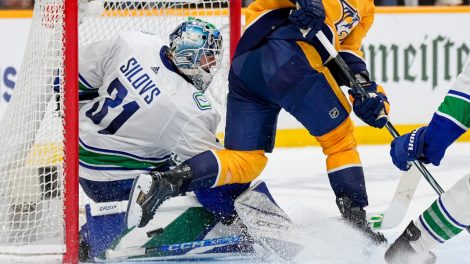Sometimes you hear a song or see a movie or look at a piece of artwork that immediately strikes you as brilliant. You may not be quite able to put your finger on it, but there’s something about the way it’s composed that makes you go “damn.”
Other times, you walk away from a first listen or watch or glance and think “good, but nothing special,” until you hear the song or see the movie or scan the artwork several more times and the layers of brilliance start to emerge.
Connor McDavid’s highlights tend to fall into one of these two categories.
On the “don’t quite know how he did that, but damn” side are typically the plays where No. 97 turns opponents into pylons or forces defenders to abandon everything they’ve ever learned about defending. Yes, his skills basically function as real-life cheat codes that allow him to physically do things no one else can, but that doesn’t necessarily explain the nuances of what he actually did to make an NHL defender look like a Peewee player.
On the “wait a second, what a play” side is much of the rest, namely the countless instances where he sets up chances in a fashion that seems ordinary but upon closer inspection, involves layers of skill and an unordinary ability to process the game.
Darryl Belfry, a player development coach who’s worked with a plethora of NHL stars, elaborated on the latter when discussing how McDavid and Sidney Crosby see the game differently than their peers on an episode of The Hockey PDOcast a few years ago.
“When you get to that level, that echelon of player, a lot of times there’s physical gifts obviously that they have that separates them, but more so than that is this understanding of how to put a play together and where, in the given set of circumstances, the advantage is.”
He cited both seeing the advantage before the play occurs and being able to rapidly act on it as the factors that differentiate the NHL’s superstars.
A related way I like to think about tiers of talent: there are many players who react to the conditions around them, fewer players who operate proactively based on those conditions, and a very small contingent who create the conditions.
We’ll examine how McDavid does the latter – specifically how he controls space in subtle ways to orchestrate plays – by breaking down three assists (one “damn” and two “wait a second” examples) from his historic season.
Each play will be shown twice, first normally and then with drawings to walk through what’s happening.
Let’s unpack some brilliance.
Secondary assist vs. the Panthers
This assist seems rather ordinary for the Oilers’ captain until you realize he single-handedly choreographs the entire sequence leading up to the goal. The rush develops over a span of roughly eight seconds and McDavid doesn’t touch the puck until the five-second mark, yet he dictates everything that unfolds up to that point and sets the stage for what transpires thereafter.
The sequence begins with Edmonton ready to exit the zone and McDavid seeing that two Florida forecheckers are caught deep, spelling the potential for a 4-on-3 rush with Edmonton’s defencemen jumping to join the play.
He then sees Florida’s left defenceman covering his winger by the wall and recognizes an opportunity to create a major advantage on this side of the ice. With the puck heading in the other direction, McDavid knows that if he slashes across the neutral zone towards it, this defender will be forced to move with him in order to protect the middle of the ice. He thus knows that if he can pull this player over far enough, one side of the rink will no longer be defended by a Florida blueliner.
Needing the puck carrier to shift the play wide for this plan to succeed, McDavid leads his teammate toward the boards by facilitating a strong-side entry with his route.
As a result of the 2-on-2 he’s organized by effectively steering both defenders to the same side of the ice, No. 97 knows he’s organized a potential 2-on-1 against a forward for his linemates on the other side of the ice.
Eager to quickly capitalize on this mismatch and aware of his defender’s momentum, McDavid casually makes a highly-skilled play to chip the puck to himself on first touch while changing direction and creating the perfect passing lane in an instant.
One dish later and voila, he’s celebrating the play he designed in his mind.
Primary assist vs. the Sharks
Here’s another play that looks like no big deal, but is again a byproduct of subtly controlling space and manipulating coverage at an elite level, this time solely with possession.
As soon as he picks up the puck in the neutral zone, McDavid sees the opposition completing a change and realizes the Sharks player on the far side in front of teammate Zach Hyman is a forward fresh off the bench who’s been thrust into the role of defenceman after a San Jose turnover.
With Hyman winding up to make a beeline to the net, McDavid knows he can exploit this matchup.
The next three seconds are simply him buying time for Hyman to “run his route” (we’ve seen this movie before) – like a quarterback coordinating with his wide receiver – but doing so in a calculated way to keep this option available.
First, McDavid prolongs his own route, veering to his left and then cutting to his right. These movements help him stall and cause his defender to momentarily halt his momentum to maintain a tight gap, which ensures there will be enough slot space in behind to eventually deliver the puck.
Then, while cutting to the right, he uses his teammate trailing the play as a decoy to divert his defender’s attention away from Hyman, who he was visually tracking. By rotating his upper body and looking over his shoulder, McDavid sells a pass back and baits his opponent into positioning his stick in this lane rather than the one to his real target.
At the same time, he crucially pulls the puck all the way across his body to his backhand and proceeds to handle it in front of his far (right) foot, which allows him to preserve space on his forehand side to pull it back at the right moment and ultimately make an unimpeded pass. If he had handled the puck exclusively in front of his near (left) foot as is usually the case for most players, he’d invite the defenceman’s stick into this space early and shorten the distance it has to travel to disrupt a play, greatly minimizing the chances of a successful pass.
By pulling the puck that far laterally in one fluid motion to his forehand, McDavid also forces the goalie to adjust his angle. As the Sharks netminder shuffles to his right, the Oiler immediately sends the puck to his left and Hyman has a gaping cage.
Touchdown, just as McDavid drew it up.
Primary assist vs. the Penguins
Our final clip is a longer sequence that offers insight into how McDavid routinely creates space for himself and his teammates in the offensive zone by putting opponents in compromised positions.
We start off with some deception and a nifty rimmed puck reception that immediately separates McDavid from his defender and leaves him with plenty of open ice to operate. Instead of skating straight at the puck and taking the most direct route to it as the majority of players would, and as the Pittsburgh defender here expects, McDavid curls to his right and skates with the puck – in the same direction as its momentum – to collect it in stride on his forehand. If you watch him closely, you’ll notice this sneaky smart tactic is one he uses regularly.
From there, we see another tactic that’s woven into the fabric of his game: carrying the puck from one sector of the offensive zone to another (i.e. moving low to high or east to west) to draw in or freeze multiple defenders and cause coverage miscues. By attacking across these sections of the offensive zone (basically across defenders), he often pulls the player originally covering him out of position and forces the guy in the next area he enters to decide whether or not to challenge him. The upshot is either space for McDavid, or space somewhere else in the zone for a teammate.
With a defenceman already chasing him here, McDavid opts to simply hold the puck and glide up the wall in a successful attempt to draw the Penguins’ winger by the dot toward him and away from his teammate at the point, who McDavid is prompting to move to the middle. By initiating this rotation and pulling the winger out of position, he creates a 2-on-1 up top for his blueliners.
And now, the “damn” portion of the play.
After falling amid a battle for the puck, McDavid spends the next three seconds playing keep away against two Penguins, largely from his knees. He doesn’t even attend to the puck for the first two seconds as he scans for support/pressure and preemptively interferes with an opponent’s stick. He then banks the puck off the boards to himself, spins off his check to meet it, and immediately identifies another opportunity to isolate an opponent.
Knowing he wants to send the puck to his teammate who’s jumping down into space, McDavid threatens to attack the middle and sells misleading information with his eyes to keep this opponent’s stick out of his intended passing lane.
With some strategic movement and clever plays, McDavid transforms an innocent cycle into a chance, puck recovery, and goal.
Parting Thoughts
Everything McDavid does in these clips seems simple enough, but when you break down the layers involved and consider the speed at which he’s doing it all – how quickly his brain is processing information, solving situational equations, and sending messages to his body – it’s hard to comprehend.
While the Los Angeles Kings will certainly try to limit McDavid’s impact in yet another first round showdown, you can’t really game plan against a guy with superior physical abilities and the mind to match.
To me, the question isn’t whether McDavid will be able to sufficiently drive Edmonton’s offence this post-season, but whether his teammates will be able to keep pace with him mentally when the intensity ramps up and the stakes are high. It won’t matter how much space he creates or how many plays he orchestrates if his teammates don’t recognize where he’s leading them or make reads early enough to capitalize on advantages.
Hyman, who knows a thing or two about capitalizing, said the following about playing with McDavid:
“He thinks the game so well. If I’m able to think it with him and get to spots that he can get the puck to, we’ll have a good chance to score.”
The playoffs are a blank canvas and it’ll be fun to see what kind of masterpieces hockey’s ultimate playmaking artist composes on his quest for his first Stanley Cup.
Vanessa Kezwer worked as a scout for the USHL’s Chicago Steel for three seasons and was a video analyst for TMU’s women’s hockey team.











